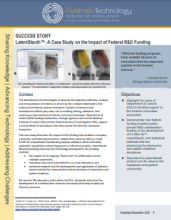Handwriting analysis
Kinematic Validation of FDE Determinations About Writership in Questioned Handprinting and Handwriting
Using subsampling to estimate the strength of handwriting evidence via score-based likelihood ratios
Advances toward validating examiner writership opinion based on handwriting kinematics
LatentSleuth: A Case Study on the Impact of Federal R&D Funding
Elucidating the relationships between two automated handwriting feature quantification systems for multiple pairwise comparisons
U-statistics for estimating performance metrics in forensic handwriting analysis
Use of an Automated System to Evaluate Feature Dissimilarities in Handwriting Under a Two-Stage Evaluative Process
On the Discriminability of the Handwriting of Twins
Tool for Document Examination
Cedar Fox Questioned Documents - A Technology Transition Workshop
Measuring the Frequency Occurrence of Handwriting and Handprinting Characteristics
Biometrics In Corrections
Cognitive Human Factors and Forensic Document Examiner Methods and Procedures
Wrongful Convictions: The Latest Scientific Research & Implications for Law Enforcement
What does science tell us about case factors that can lead to a wrongful conviction? Dr. Jon Gould of American University will discuss the findings of the first large-scale empirical study that has identified ten statistically significant factors that distinguish a wrongful conviction from a "near miss." (A "near miss" is a case in which an innocent defendant was acquitted or had charges dismissed before trial). Following Dr. Gould's presentation, Mr. John R.
See the YouTube Terms of Service and Google Privacy Policy
Developing Effective Methods for Addressing Contextual Bias in Forensic Science
Just Science Podcast: Episode 38: 2018 IPTES: Just Handwriting Statistics
Sufficiency and Complexity Factors in Handwriting Examination




